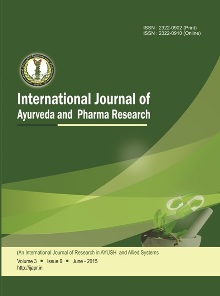In-Vitro Antifungal Evaluation of Kushthaghna Mahakashaya Plant Extracts Against Dermatophytes: A Study on Epidermophyton Floccosum, Microsporum Canis and Trichophyton Mentagrophytes
Abstract
Now days skin diseases are very common. In society, the sufferer faces physical, emotional and socioeconomic embarrassment. In Ayurveda, skin diseases have been comprehended under the heading of Kushtha which causes vitiation as well as discoloration of the skin. In contemporary medical science, Dadrukushtha is correlated to dermatophytosis which is caused by mainly three fungal strains i.e. Trichophyton, Microsporum and Epidermophyton. Acharya Charak mentioned the Kushthaghna mahakashaya for the management of Kushtha. In this study, anti-fungal activities of Kushthaghna mahakashaya plants were tested against these three common pathogenic fungal strains. Material and Methods: These plants were subjected to solvent extraction using hot solvent of increasing polarity into ethanol using Soxhlet apparatus. The antifungal activity of crude extracts was screened against the test organisms by agar well diffusion method. Result: Out of these tested plants, three plant extracts Semicarpus anacardium, Embellica officinalis and Curcuma longa showed significant antifungal activity against all three fungal strains. Five plant extracts did not show activity against E. floccosum but showed activity against M. canis and T. mentagrophytes. Largest ZOI (18 mm) was produced by Embelia ribes against M. canis. Conclusion: Based on this study, it can be concluded that some plants of Kushthaghna mahakashaya group have significant antifungal activity against selected fungal strains. Their significant ZOIs prove that Kushthaghna mahakashaya play important role in treating fungal diseases (Kushtha).
Copyright (c) 2025 International Journal of Ayurveda and Pharma Research

This work is licensed under a Creative Commons Attribution-NonCommercial-ShareAlike 4.0 International License.


